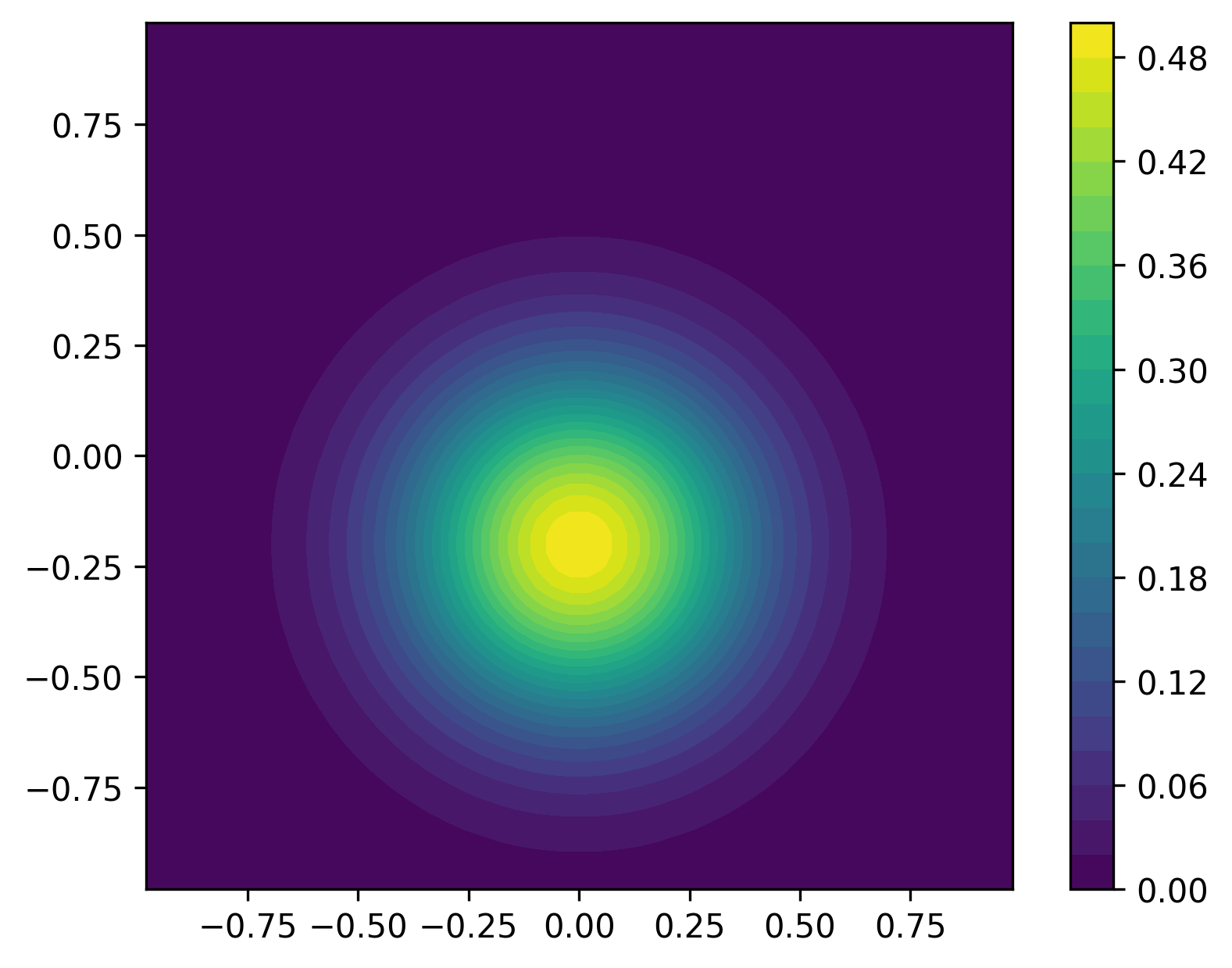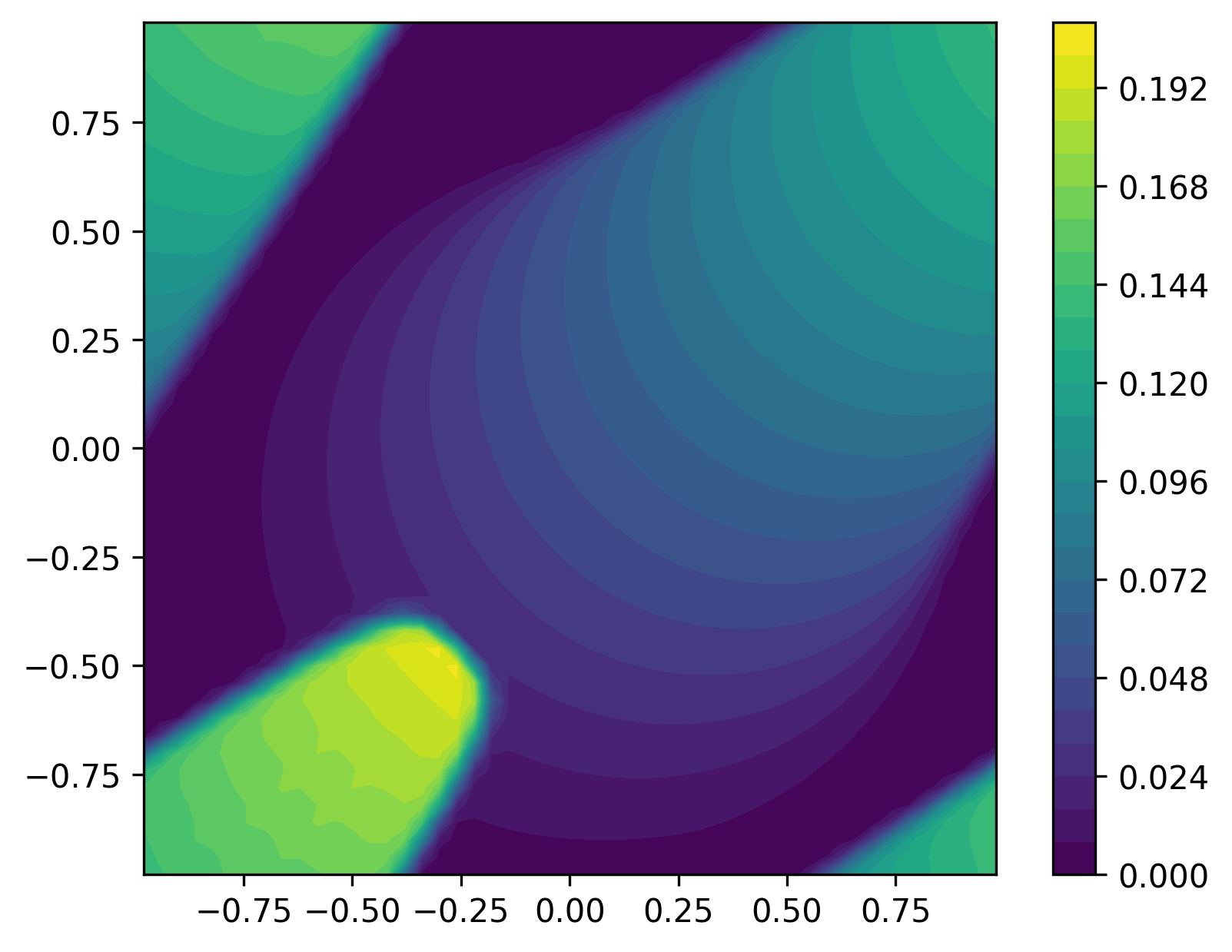2D Burgers (Periodic BCs)#
This problem solves the following 2D nonlinear viscous Burgers equations
Domain is \([-1,1]^2\) with periodic BC
Initial conditions are: \(u = v = \alpha \exp( - \frac{(x-x_0)^2+(y-y_0)^2}{\delta} )\)
Default settings: \(\alpha = 0.5\), \(\delta = 0.15\), \(x_0=0, y_0=-0.2\), \(D = 0.00001\)
Mesh#
python3 pressio-demoapps/meshing_scripts/create_full_mesh_for.py \
--problem burgers2d_periodic_s<stencilSize> -n Nx Ny --outDir <destination-path>
where
Nx, Nyis the number of cells you want along \(x\) and \(y\) respectively<stencilSize> = 3 or 5 or 7: defines the neighboring connectivity of each cell<destination-path>is where you want the mesh files to be generated. The script creates the directory if it does not exist.
Important
When you set the <stencilSize>, keep in mind the following constraints (more on this below):
InviscidFluxReconstruction::FirstOrderrequires<stencilSize> >= 3InviscidFluxReconstruction::Weno3requires<stencilSize> >= 5InviscidFluxReconstruction::Weno5requires<stencilSize> >= 7
C++ synopsis#
#include "pressiodemoapps/advection_diffusion2d.hpp"
int main(){
namespace pda = pressiodemoapps;
const auto meshObj = pda::load_cellcentered_uniform_mesh_eigen("path-to-mesh");
const auto probId = pda::AdvectionDiffusion2d::BurgersPeriodic;
const auto inviscidScheme = pda::InviscidFluxReconstruction::FirstOrder; // or Weno3, Weno5
const auto viscousScheme = pda::ViscousFluxReconstruction::FirstOrder; // must be FirstOrder
// A. constructor for problem using default values
{
auto problem = pda::create_problem_eigen(meshObj, probId, inviscidScheme, viscousScheme);
}
// B. setting custom coefficients
{
using scalar_type = typename decltype(meshObj)::scalar_t;
const auto alpha = /* something */;
const auto delta = /* something */;
const auto D = /* something */;
const auto x0 = /* something */;
const auto y0 = /* something */;
auto problem = pda::create_problem_eigen(meshObj, probId, inviscidScheme,
viscousScheme, alpha,
delta, D, x0, y0)
}
}
Python synopsis#
import pressiodemoapps as pda
meshObj = pda.load_cellcentered_uniform_mesh("path-to-mesh")
probId = pda.AdvectionDiffusion2d.BurgersPeriodic
inviscidScheme = pda.InviscidFluxReconstruction.FirstOrder; # or Weno3, Weno5
viscousScheme = pda.ViscousFluxReconstruction.FirstOrder; # must be FirstOrder
# A. constructor for problem using default values
problem = pda.create_problem(meshObj, probId, inviscidScheme, viscousScheme)
# B. setting custom coefficients
alpha = # something
delta = # something
D = # something
x0 = # something
y0 = # something
problem = pda.create_burgers_2d_problem(meshObj, probId, inviscidScheme,
viscousScheme, alpha,
delta, D, x0, y0)
Sample Plot#
Representative plot of u at \(t=0\) (left) and \(t=10.\),
using a 50x50 mesh with Weno5 and RK4 time integration with \(dt = 0.005\),
and the default settings for the parameters:


Notes:#
Important
Note that we currently support only first order viscous flux reconstruction, which leads to a second-order scheme.